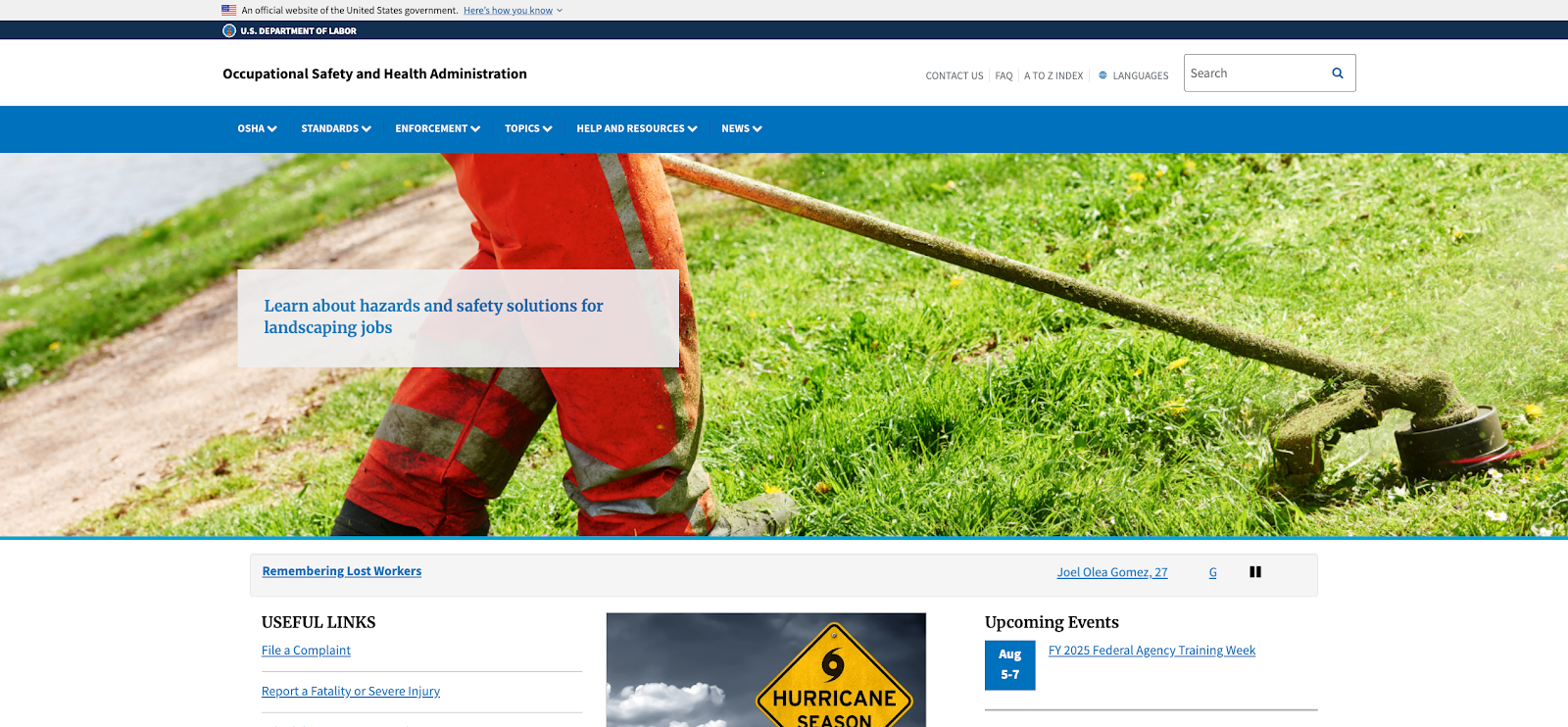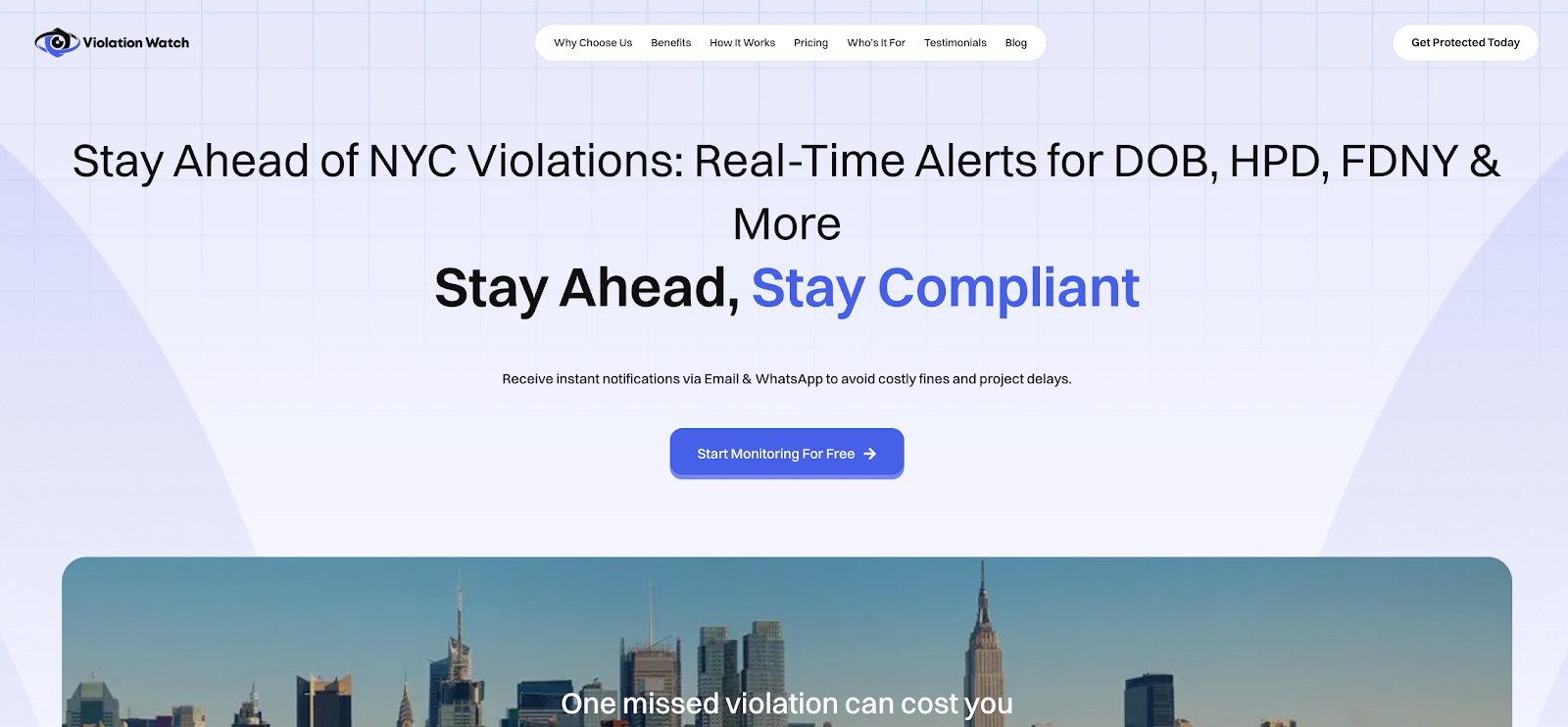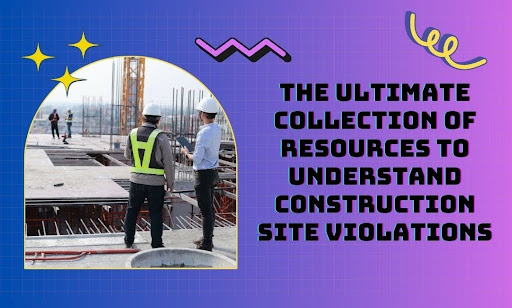Every delay costs money. Every violation risks more than a stop-work order. Yet most people still scramble after the fact—Googling acronyms, guessing what triggered the fine, and pulling together paperwork after the inspector’s already left. Why? Because they don’t have a system. And in a city like New York, that gets expensive fast.
This article cuts through the noise. We’ve pulled together the most useful, practical, and outcome-focused resources to help you get ahead of construction site violations—before they show up on your job site, or worse, in your mailbox. This isn’t theory. These are the tools pros actually use.
Here’s what we’re breaking down:
- OSHA’s official platform and what most people overlook in it
- Construction safety publications that go beyond hard hats and signage
- Legal and compliance databases that track citations and case law
- AI-powered site monitoring tools are gaining traction in NYC builds
If you’re constantly reacting to violations, it’s time to flip the script.
What Most People Miss on OSHA’s Site

OSHA.gov isn’t designed for casual browsing. It’s structured like a compliance engine—purpose-built for safety directors, field engineers, and site managers who need clear answers and defensible procedures under federal scrutiny.
Yet most users treat it like a bulletin board. They read a regulation or two, download a poster, and move on. What gets missed? The tools that actually shape enforcement, build defensible protocols, and help crews stay ahead of site-specific risks—before OSHA inspections lead to citations, delays, or more serious enforcement.
Below is what OSHA’s website actually offers—and how professionals extract value from it.
Standard Interpretations Database
At face value, the Code of Federal Regulations (29 CFR Part 1926) defines the baseline for construction safety. But standards are broad. Field conditions aren’t. That’s where OSHA’s Standard Interpretations come in.
Each interpretation is an official response to an employer’s real-world compliance question, with references to:
- The specific standard in question (e.g., §1926.451 for scaffolding or §1926.502 for fall protection)
- The context of use (residential vs. commercial, temporary vs. permanent structures)
- The permissible scope of deviation or equipment substitution
- Legal precedent or prior enforcement action relevant to the scenario
For construction employers, these interpretations serve as guardrails when adapting policy to non-standard job site conditions. They help clarify enforcement expectations and close gaps between regulatory intent and site execution.
Pro Tip: Bookmark the page and filter results by subpart. Cross-reference interpretations with your site-specific method statements or engineering control plans to maintain safety protocols that align with legal precedent.
Enforcement Data and Inspection Records
OSHA’s Enforcement Search Tool is a direct line into what compliance officers are prioritizing right now.
By searching by NAICS code, company name, or state, you can access:
- Citation history by standard (e.g., repeated violations of §1926.651 for excavation hazards)
- Penalty breakdowns (initial amount vs. current amount after contest or settlement)
- Inspection type (planned, complaint-based, or fatality-related)
- Abatement verification status and final disposition
This data allows firms to flag where safety violations are spiking and adjust internal risk assessments before becoming a target. It also shows where OSHA inspectors are focusing enforcement, for example, in high-density construction zones or sites with recent injury reports.
eTools and Hazard Identification Modules
The Construction eTool section isn’t a simple checklist repository. It breaks hazard zones down into function-specific guidance, such as:
- Working from height (Subpart M)
- Excavations (Subpart P)
- Cranes and rigging (Subpart CC)
- Noise exposure (1910.95 cross-referenced for hearing conservation)
These eTools also provide actionable modules for electrical safety, fall protection, confined spaces, and other high-risk tasks. Each includes illustrations, case examples, and linked guidance to help translate regulation into task-level safety practices.
This is critical when developing:
- Job Hazard Analyses (JHAs)
- Task-specific method statements
- Tailgate talks and new hire employee training
When applied properly, these modules don’t just check boxes—they help teams improve workplace safety where it matters: at the task level.
Whistleblower Protection Programs
OSHA’s Whistleblower and Anti-Retaliation section isn’t only about HR disputes. It’s a barometer of crew-level trust. Anonymous complaints often trigger site inspections, especially in regions with active union oversight or recent injury reports.
Here’s what’s publicly available:
- Protected categories (e.g., raising safety concerns, requesting PPE, refusing unsafe work)
- Common complaint types and outcomes
- Industries under heightened scrutiny for retaliation
- Timeframes for investigation and case resolution
Knowing how whistleblower cases unfold helps site leaders build a safety culture that encourages reporting, instead of punishing it. It also helps crews report serious physical harm risks without fear of retaliation, reducing long-term exposure for project owners.
Recommendation: Review this section quarterly with legal or HR teams to align retaliation protection procedures and minimize enforcement exposure.
Weekly Fatality and Catastrophe Reports
OSHA posts weekly fatality reports for incidents reported nationwide. They include:
- Date and location of the incident
- Brief description of the event (e.g., “Worker crushed by boom during crane disassembly”)
- Employer name and industry
- Preliminary classification of cause
These aren’t sanitized summaries. They’re raw entries—often written before a formal inspection has concluded. Still, they offer immediate insight into where construction equipment, process failure, or supervision lapses are contributing to repeatable patterns. Use them to update site safety briefings, retool JSAs, and tighten controls around powered industrial trucks and other high-risk gear.
OSHA’s website isn’t a document dump. It’s a real-time, operationally relevant resource. It allows you to track trends, decode enforcement, and structure a safe working environment backed by precedent, not guesswork. When used consistently, it becomes a foundational tool to protect crews, reduce fines, and run smarter construction projects.
Safety Publications That Go Far Beyond the Basics
The best-run construction sites don’t rely on laminated posters and toolbox talks alone. They build their protocols around high-quality, technically grounded safety publications—resources that break down hazards, controls, and enforcement trends with field-level specificity.
These aren’t dusty manuals. They’re how safety professionals stay ahead of OSHA updates, adapt to shifting inspection priorities, and train site crews with material that sticks, especially in sectors where construction work overlaps multiple trades, environments, and hazard classes.
Here’s what the best sources offer—and why they matter.
Annotated Standards and Commentary Manuals
General standards are useful. But annotated editions of construction safety codes go further. These publications include:
- Explanations of code logic and engineering intent
- Visuals and breakdowns of compliant vs. non-compliant scenarios
- Technical commentary from certified safety professionals and PE reviewers
This added context is critical when writing internal procedures, managing trade-specific risks (like structural steel vs. MEP), or defending your interpretation during a walk-through. They also help sites respond to previous violations with corrective measures tied to legal precedent.
Look for: Manuals that update with each revision of 29 CFR 1926 and include jurisdiction-specific notes for city-level enforcement.
Hazard-Specific Field Guides
Fall protection. Trenching and excavation. Electrical lockout/tagout.
The best safety publications focus on one hazard category and treat it with operational depth. These field guides often include:
- Detailed PPE specifications by trade and risk level
- Task sequencing to reduce cumulative risk (e.g., install edge protection before installing floor decking)
- Monitoring and control protocols (like continuous air monitoring in confined spaces)
High-quality field guides also include risk-mitigation strategies for uneven surfaces, falling object hazards, and being struck by incidents, all of which contribute to a large portion of workplace injuries reported on active jobsites.
These are especially valuable when onboarding subs or writing activity hazard analyses (AHAs) for high-risk tasks.
Incident Investigation Handbooks
Some of the most informative safety publications are built from post-incident analysis. They teach process, not theory. You’ll often find:
- Step-by-step protocols for incident scene control
- Interview guides and sample witness statement forms
- Root cause analysis frameworks like 5-Whys and fault tree analysis
- Guidance on documentation that stands up to regulatory review
Used correctly, these handbooks help crews recognize significant threat patterns before they cause serious injury, and guide teams through proper emergency response procedures, especially where hazardous chemicals or natural disasters are part of site exposure.
Note: Choose guides that are written for construction—not generic workplace safety—so they reflect multi-employer worksites and trade-specific challenges.
Safety Management System (SMS) Templates
Some publications go beyond rules and checklists. They help you build the systems that enforce those rules.
Strong SMS resources typically include:
- Organizational structure and roles for field-level safety accountability
- Training matrices by task and trade
- Sample corrective action tracking logs
- Internal audit and inspection templates
For operations managing high-risk tasks like working around respiratory risks or handling heavy lifts, SMS documents can connect task planning with PPE requirements such as respiratory protection and the right equipment selection—two areas frequently flagged during audits.
These resources also allow firms to ensure compliance across distributed job sites, keeping crews aligned and exposures tightly controlled.
Industry-Focused Journals and Whitepapers
While many safety publications aim at field crews, some target decision-makers. Industry journals and whitepapers offer research-based analysis on:
- Policy changes and upcoming enforcement trends
- Emerging materials and tools that reduce site risk
- Comparative studies of safety program performance across different contract models
These sources help GCs and project executives align strategy with operational planning and subcontractor oversight, especially in areas where legal consequences may result from mismanaged hazards or unresolved safety issues. High-value journals often reference data from labor statistics, grounding their analysis in performance outcomes that matter most to project leadership.
Publications like these are more than educational—they’re operational. When chosen with purpose, they help sites control recognized hazards, prevent fall injury, and elevate overall safety without slowing production. Used consistently, they shift how your team plans, trains, reacts, and how it avoids violations altogether.
Where to Track Enforcement and Legal Outcomes

Field inspections are only half the story. What happens after a citation is issued—when companies contest, appeal, or settle—shapes how violations get enforced in practice. That’s where legal and compliance databases come in. They offer real-time access to case law, administrative rulings, and citation trends that influence how regulations are interpreted across construction sites.
These databases aren’t limited to attorneys. Construction pros use them to review decisions, spot enforcement inconsistencies, and refine site policies to hold up under scrutiny.
Compliance Portals with Searchable Citation Records
Certain platforms specialize in tracking violations by agency, location, or violation type. These portals allow users to:
- Filter by inspection type (e.g., complaint-based, programmed, referral)
- Analyze trends based on NAICS code or employer size
- Review citation language used in repeat violations
- Access summaries of contested or withdrawn citations
Used effectively, these records help site leads predict enforcement behavior and structure hazard controls that reflect actual inspection trends, not generic code interpretation.
Case Law Libraries Focused on Workplace Safety
Beyond administrative citations, you’ll find searchable databases that index rulings from the Occupational Safety and Health Review Commission (OSHRC), state-level equivalents, and federal appeals. These databases can show:
- How courts ruled on vague or disputed safety standards
- Which procedural missteps caused citations to be vacated
- Whether new technologies or construction methods triggered regulatory confusion
- Legal benchmarks for multi-employer site liability
These insights help project leads and compliance officers align their documentation practices and subcontractor coordination with how judges and review boards rule in real cases.
Regulatory Interpretation Bulletins and Legal Briefing Sheets
Many of the top legal compliance publishers issue monthly or quarterly bulletins breaking down major rulings, citation spikes, or enforcement shifts. These are structured as:
- Case summaries with factual background and procedural history
- Legal rationale from the ruling body
- Risk mitigation takeaways for contractors, subs, and safety consultants
Professionals often use these bulletins in internal compliance training, quarterly safety planning, or while preparing documentation for contested citations.
How This Information Gets Used On Site
Legal and compliance databases are more than research tools. In the field, they drive action:
- A superintendent facing a repeat citation can search for precedent on mitigation credits or reclassification
- A safety manager updating training protocols can cite real rulings to explain why certain steps are mandatory
- A project executive planning self-audits can model documentation practices based on cases that held up during review
This legal intelligence helps construction pros move from code interpretation to enforceable policy.
AI Monitoring Tools Shaping How Violations Get Spotted

Construction tech isn’t limited to scheduling apps and punch list trackers. AI-powered site monitoring is now reshaping how safety teams understand—and prevent—violations across NYC builds.
These tools aren’t just about recording footage. They analyze behavior, flag risks, and track patterns that human eyes often miss. For crews working under DOB oversight or juggling multiple subs, that level of visibility is no longer optional.
Turning Site Footage Into Compliance Signals
Modern AI monitoring systems use computer vision to:
- Detect hard hats and harnesses in real time
- Identify high-risk behaviors like walking near open edges or improper scaffold access
- Track personnel movement in restricted zones
- Map congestion near heavy equipment or material staging areas
The key advantage? These systems create timestamped, searchable logs that help safety officers review incidents, verify training effectiveness, and document corrective actions before an inspector issues a citation.
They also support trend analysis. If violations keep surfacing during rebar tying or material hoisting, AI logs can show exactly when and how those risks are escalating on the job.
Tools Gaining Adoption on NYC Sites
Several platforms are already embedded in local construction workflows:
- Smartvid.io – Uses photo and video analysis to score safety risks and issue predictive alerts based on jobsite data.
- Pillar Technologies – Monitors environmental hazards (heat, dust, vibration) alongside human activity using AI-backed sensors.
- Everguard.ai – Tracks PPE use and proximity to danger zones through real-time alerts and behavior-based learning models.
These tools are built to complement field inspections, not replace them. They work best when tied directly into a company’s safety program, with trained staff reviewing and acting on the insights.
But There’s a Blind Spot
AI tools shine when monitoring visual risks. But they don’t cover violation notices, legal deadlines, or agency-specific rules. They can’t track a stop work order from the DOB or flag an FDNY infraction before the letter hits your mailbox.
That’s where ViolationWatch fills the gap. It’s the only tool purpose-built to unify every NYC construction enforcement agency under one dashboard. While AI shows you what happened on-site, ViolationWatch shows you what the city sees. And that’s what determines fines, penalties, and work stoppages.
The Tool That Connects the Dots Across All NYC Violations in Construction Industry

You can monitor hardhat usage with AI. You can train your crews with OSHA’s eTools and cross-check legal interpretations for gray areas. But none of that helps if you miss the violation notice that triggers the fine. That’s the gap ViolationWatch was built to close.
It’s not another general compliance platform. It’s a laser-focused, NYC-specific violation tracker built for contractors, developers, property owners, and site managers who need immediate, clear insight into enforcement risk, agency by agency, building by building.
And in a regulatory environment shaped by health administration standards, overlooked compliance risks are a direct threat to your job timelines, margins, and workforce.
What Makes It a Resource, Not Just a Tracker
ViolationWatch doesn’t stop at showing you open violations. It gives you real-time access to compliance data that helps explain why violations occur, when they hit hardest, and what you need to act on next.
Here’s how it helps you understand and manage site violations more effectively than anything else available:
- Comprehensive tracking across NYC agencies: It covers DOB, HPD, FDNY, DEP, DOH, DSNY, ECB, DOT, DEC, and DOF. You don’t need to jump between siloed portals or wait for staff to manually check for updates. This is especially critical in the construction industry, where timelines are tight and non-compliance costs scale fast.
- AI-powered scanning: Violations are pulled in automatically and analyzed—no human lag, no missed notices. AI reads through potential red flags tied to construction hazards before they escalate into agency actions.
- Real-time alerts that go where your team actually works: Notifications come through WhatsApp and email, so the right people move fast, whether they’re in the trailer or across the borough. With multiple trades, rotating subs, and frequent shifts, this supports construction workplace coordination where speed is everything.
- Original violation records, all in one dashboard: You get the source documents. No filtered summaries. No delays. Just the facts you need to respond quickly and document compliance accurately. A powerful move for GCs trying to manage personal protective equipment protocols without missing regulatory changes.
- Multiple location monitoring: If you’re overseeing more than one job, you can manage all addresses from a single, organized interface. This helps larger construction companies keep operations clean across boroughs and reduce admin overload.
- Automated workflows that reduce compliance overhead: You’re not chasing paperwork. You’re responding to structured updates, with built-in alerts and filters to prioritize the most time-sensitive issues. These features support real enforcement of safety procedures and hazard communication practices on high-turnover crews.
Transparent Pricing That Fits the Way You Operate
ViolationWatch is accessible even if you’re watching just one property:
- Free trial covers a single address with 311 violation tracking and basic access
- $9.99/month per address unlocks full agency coverage, real-time AI monitoring, and team-wide alerts
No hidden tiers. No add-ons that double your bill. It’s priced for clarity and scale.
In a city where one missed hearing can stall your entire site, having a dedicated violation monitoring resource isn’t a luxury—it’s baseline protection. ViolationWatch doesn’t just notify you. It keeps you informed, alert, and proactive with the right level of detail, exactly when you need it. Whether you’re managing risk from power tools, supervising crews near heavy machinery, or correcting unreported safety hazards, this is how you protect your operations from potential hazards—and your crews from health hazards.
It also reinforces proper training and consistent enforcement of safety measures, helping you stay focused on what drives construction worker safety, not scrambling after a fine lands on your desk.
Make Construction Site Violations Easier to Understand with the Right Tools
You’ve seen how different tools give you different angles—technical clarity, safety context, legal insight, field data. But the real value kicks in when you use them together. That’s when your process shifts from reactive to informed, from overwhelmed to organized.
The outcome? You stop chasing violations and start managing them with structure. You don’t wait for fines—you prevent them by spotting patterns earlier. You reduce the noise, close the gaps between trades, and build a process that runs smoother on every job.
Let’s call it what it is: a smarter way to run compliance.
- OSHA tools show you what the rules actually mean when applied
- Publications teach your teams how to apply them without cutting corners
- Legal databases keep you off the wrong side of enforcement
- AI monitoring closes the visibility gap between planning and reality
- ViolationWatch brings it all into one place—live, trackable, and built for the way New York actually works
Skip the guesswork. Build with confidence. Let compliance support the project instead of slowing it down. And if you’re ready to finally stop jumping between city portals and late alerts, ViolationWatch is the software solution that brings every moving part under control.

